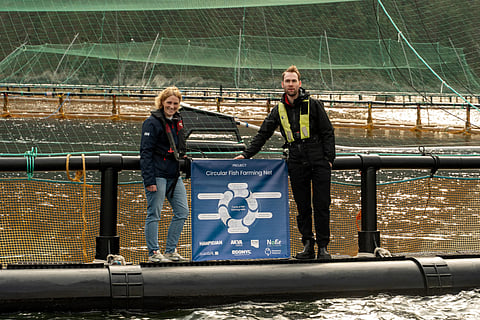

Jostein Iversen, sustainability advisor at Grieg Seafood, and Karen Kvalheim, innovation manager for research at AKVA Group Egersund Net.
Grieg Seafood
Grieg Seafood has seen the world's first circular net for Atlantic salmon production put into operation in two of the cages at its facility in Hundaneset, Rogaland (Norway). This innovative project was also made possible through collaboration with Nofir, AKVA group Egersund Net, Hampidjan, and Aquafil.
The facility has four cages that produce around 29 million fish meals per year. The new circular nets will remain in use for one year, then they will be removed for maintenance and reused.
"It would be fantastic if these bags one day became competitive, and perhaps even the new standard in the aquaculture industry. In any case, I am sure that this type of collaboration will be crucial for us to be able to benefit from each other's expertise and move forward towards a greener fisheries and aquaculture industry," said Jostein Iversen, Sustainability Advisor at Grieg Seafood.
At its factory in Slovenia, Aquafil repurposes industrial waste to create new products, despite it being an expensive and hard-to-commercialize process. The Italian company proposed using its chemically recycled granulate for the production of fishing nets.
Additionally, Karen Kvalheim, Innovation Manager for Research at AKVA Group Egersund Net, took charge of ensuring that the recycled nets met the same stringent quality standards as the traditional ones.
"It is absolutely crucial that the recycled net bags are as durable and robust as the traditional ones. We have previously seen that mechanical recycling produces materials of lower quality. However, these bags made from chemically recycled material show the same quality as the traditional ones," explained Kvalheim.
According to the manager, all tests were successfully passed, from testing the fabric’s strength and abrasion resistance to the effectiveness of the protective coating, all conducted on a small scale in controlled laboratory settings.
